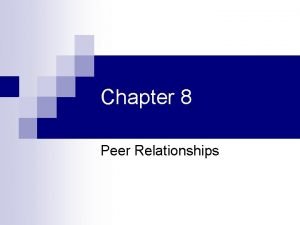Workplace Friendships Examining Friendships at Work and their

- Slides: 1

Workplace Friendships: Examining Friendships at Work and their Impact on Job Satisfaction and Perceived Productivity Marissa Jones, Jenna Stromberger, Elizabeth Pape, Kelsey Chapman, and Adam Borremans Faculty Mentor: Dr. Mary Hoffman Communication and Journalism Department University of Wisconsin – Eau Claire Abstract This study investigated the perceived relationship between workplace friendship and productivity. Organizational communication professionals have long been interested in the impact of interpersonal relationships in the workplace. This study used qualitative methods to investigate communication between friends in the workplace. Results indicated that participants perceive that friendships at work enhance satisfaction and productivity. Literature Highlights v Sias and Cahill (1998) explained that through maintaining relationships within the workplace, employees felt a sense of friendship with other coworkers, and in return may have felt more satisfaction at work. v Feely and Hwang (2008) measured perceived productivity by way of a questionnaire, and found that workplace friendships enhanced the sharing of knowledge and experience and increased helping behaviors. Methods Participants v 126 participants v 19% Male, 79% Female v 12% age 18 -20, 67% age 21 -23, 21% age 24+ v 9% worked 0 -9 hours per week, 25% 10 -19, 21% 20 -29, 15% 30 -39, 30% 40 Data Gathering v Online survey through Qualtrics v Snowball sampling through email and Facebook v Five questions asked respondents about friendships in the workplace and related perceived productivity and satisfaction Data Analysis v Thematic analysis conducted individually and as a team “We talk about school, roommates, what we’re doing for break or events…surface things. ” Results and Conclusions Our analysis revealed two possible levels of friendships in organizational settings: v Surface Level Friendships: characterized as friendships in which interactions take place but may not include meaningful conversations. Topics in these workplace friendships may include small talk, work, or popular culture. v Deep Friendships: characterized as friendships in which interactions are often more personal and meaningful. Topics in these workplace friendships my include relational issues, advice seeking, personal difficulties, or support related to work issues. Our analysis revealed that employees perceive that workplace friendships increase productivity for the following reasons: v Team Atmosphere: Workplace friendships increase cohesion. Cohesive groups can solve problems more efficiently and provide assistance when needed. v Improved Communication: Having friends at works allows people to more comfortably share ideas and ask questions. It builds trusts which can increase productivity. Making personal connections at work helps decrease miscommunication that may occur when communicating with mere acquaintances. v Supportiveness: Friends create an emotionally supportive environment which can lead to increased productivity. Work can be stressful but having friends can reduce the stress. “We discuss work related issues both in venting and problem solving, share personal joys, worries, concerns, and plan after work activities. ” Research Question RQ 1: What impact do employees perceive that workplace friendships have on productivity? Friends at work are very beneficial because we are able to effectively communicate and help each other out to get our tasks done faster. ” “It gives me a nice break. Once I get a break I am able to be more productive after. ” “Some think conversations waste time. I believe I’m building good will, finding solutions and building cohesion on the team. ” Implications v For Individuals: Individuals in organizations may wish to cultivate deep friendships in order to enhance their experiences at work and increase their perceived productivity. v For Organizations: Organizations may want to encourage workplace friendships in order to capitalize on the potential benefits for teamwork, communication, and supportiveness. Acknowledgements We thank the Office of Research and Sponsored Programs for supporting this research and Learning and Technology Services for printing this poster.

